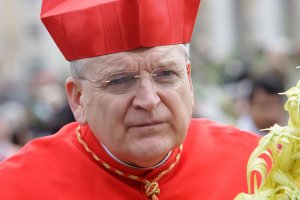
Cardinal Burke, the well-known conservative, gave an interview recently in which he made statements which are themselves in need of correction. Already in November of 2016, he said: “There is, in the Tradition of the Church, the practice of correction of the Roman Pontiff. It is something that is clearly quite rare. But if there is no response to these questions, then I would say that it would be a question of taking a form al act of correction of a serious error.”
By “questions” he is referring to the Dubia which he and three other cardinals presented to Bergoglio in 2016. He had no response from Bergoglio, so since late last year he has been saying that there ought to be a “formal correction” of the “pope.” He claims that there is a tradition of doing so. This is not true. There was never a case of any cardinal or bishop correcting the pope’s magisterium. There are cases of public corrections of their behavior. Saint Paul corrected St. Peter for his having conceded to the Jews a separation from the Gentiles when they were eating. There was, however, no question of doctrine here. The theologians of the University of Paris publicly corrected John XXII on a matter of doctrine, but which he taught only as a private doctor, and not as the magisterium of the Church.
I challenge the Cardinal to tell us (1) where the magisterium of the Church was ever wrong about anything; and (2) when and where prelates of the Church corrected the magisterium of the pope.
The very notion of correcting a pope in a matter of magisterium ruins the teaching authority of the Church. To which doctrine do we give assent? To the pope’s doctrine or to the correctors’ doctrine? Bergoglio has already characterized Amoris Lætitia as ordinary magisterium, which, if he were a real pope, would require our assent under pain of mortal sin. The only thing that a group of cardinals could do, which would be in conformity with the constitution of the Church, would be to accuse him of heresy, and move to remove his election from him, and elect another. But they would not do their duty by merely “correcting” the “pope.”
It just adds to the confusion. It is like trying to fix a deep stab wound with a band-aid. A pope teaching false doctrine is a dagger in the heart of the Catholic Church. He must be removed.
Secondly, Cardinal Burke said in a recent interview in The Wanderer that Pope Honorius was deposed from the papacy. This is plainly not true. Pope Saint Leo II did not uphold the deposition from the papacy of Pope Honorius contained in the acts of the Third council of Constantinople, but instead mitigated the sentence by saying that he fanned the flames of heresy by his negligence in condemning it. There has never been a case of a pope’s having been deposed owing to the teaching of heresy. But Cardinal Burke is right inasmuch as teaching heresy, or even publicly holding heresy, merits a deposition from office. For in fact, the teaching of heresy as magisterium is a sign that he was never pope in the first place.
But the Cardinal and those prelates who agree with him are in a position to do a great deal of good. Even a “formal correction,” although making no sense for the reasons I set forth, would at least be a step in the right direction. It would alert people who still claim to be faithful Catholics, as well as the Novus Ordo hierarchy, to the fact that there is a doctrinal problem in Bergoglio. By the grace of God, maybe other steps could be taken in the right direction from there.
